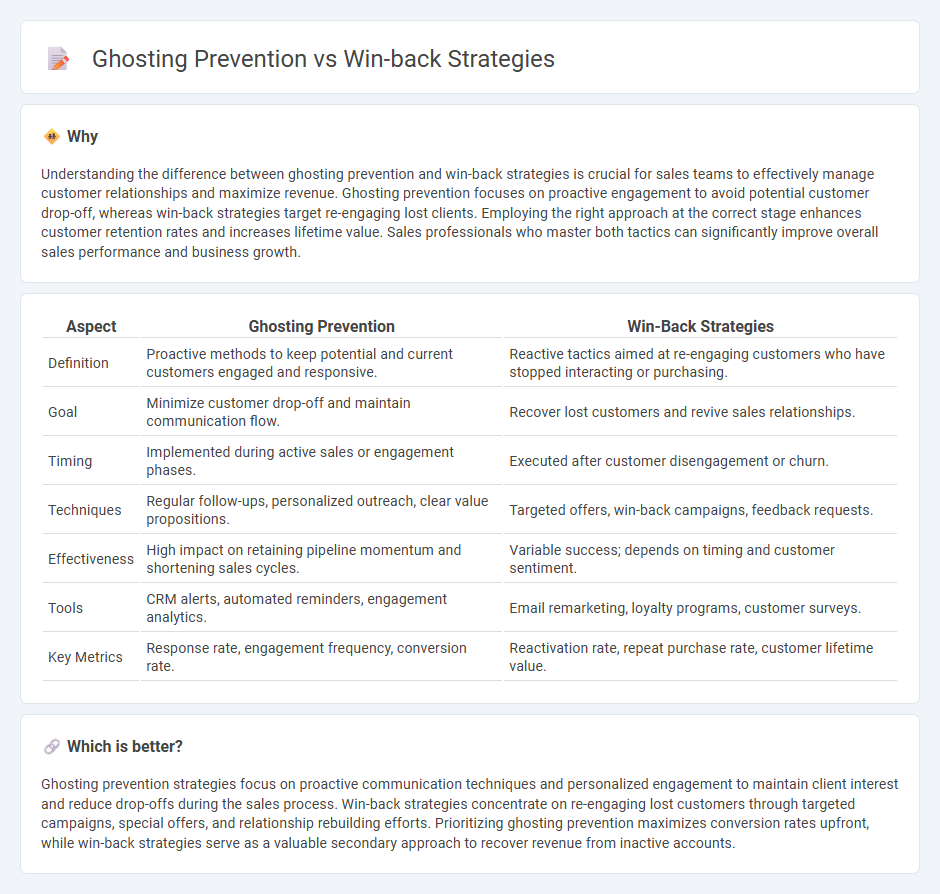
Sales teams face challenges in maintaining customer engagement, where ghosting prevention focuses on proactive communication to sustain interest, while win-back strategies target re-engaging lost leads or inactive clients. Understanding the metrics and behavioral cues that signal potential ghosting helps tailor timely interventions, improving conversion rates and customer retention. Explore deeper insights on optimizing these approaches to maximize sales success.
Why it is important
Understanding the difference between ghosting prevention and win-back strategies is crucial for sales teams to effectively manage customer relationships and maximize revenue. Ghosting prevention focuses on proactive engagement to avoid potential customer drop-off, whereas win-back strategies target re-engaging lost clients. Employing the right approach at the correct stage enhances customer retention rates and increases lifetime value. Sales professionals who master both tactics can significantly improve overall sales performance and business growth.
Comparison Table
| Aspect | Ghosting Prevention | Win-Back Strategies |
|---|---|---|
| Definition | Proactive methods to keep potential and current customers engaged and responsive. | Reactive tactics aimed at re-engaging customers who have stopped interacting or purchasing. |
| Goal | Minimize customer drop-off and maintain communication flow. | Recover lost customers and revive sales relationships. |
| Timing | Implemented during active sales or engagement phases. | Executed after customer disengagement or churn. |
| Techniques | Regular follow-ups, personalized outreach, clear value propositions. | Targeted offers, win-back campaigns, feedback requests. |
| Effectiveness | High impact on retaining pipeline momentum and shortening sales cycles. | Variable success; depends on timing and customer sentiment. |
| Tools | CRM alerts, automated reminders, engagement analytics. | Email remarketing, loyalty programs, customer surveys. |
| Key Metrics | Response rate, engagement frequency, conversion rate. | Reactivation rate, repeat purchase rate, customer lifetime value. |
Which is better?
Ghosting prevention strategies focus on proactive communication techniques and personalized engagement to maintain client interest and reduce drop-offs during the sales process. Win-back strategies concentrate on re-engaging lost customers through targeted campaigns, special offers, and relationship rebuilding efforts. Prioritizing ghosting prevention maximizes conversion rates upfront, while win-back strategies serve as a valuable secondary approach to recover revenue from inactive accounts.
Connection
Ghosting prevention and win-back strategies are interconnected through their focus on maintaining and restoring customer engagement in sales processes. Effective ghosting prevention techniques, such as personalized follow-ups and timely communication, reduce the likelihood of clients disappearing, while win-back strategies leverage data-driven insights to re-engage lost prospects and revive dormant accounts. Combining these approaches helps sales teams sustain strong pipelines and maximize revenue by minimizing client attrition and capitalizing on regained interest.
Key Terms
**Win-back Strategies:**
Win-back strategies emphasize re-engaging lost customers through personalized offers, targeted communication, and loyalty incentives to rekindle brand interest and drive repeat sales. These tactics leverage data analytics to identify churn reasons and tailor campaigns, boosting customer retention rates significantly. Discover effective win-back strategies to revive your customer base and enhance long-term revenue growth.
Churn Analysis
Win-back strategies target customers who have already churned by using personalized offers, feedback loops, and behavior-based triggers to regain engagement. Ghosting prevention in churn analysis emphasizes early detection of disengagement signs through predictive analytics, real-time monitoring, and proactive communication to retain at-risk customers. Explore effective techniques to optimize customer retention and reduce churn by diving deeper into churn analysis methodologies.
Re-engagement Campaign
Re-engagement campaigns are essential for win-back strategies, targeting inactive customers through personalized offers and relevant content to rekindle interest and restore brand loyalty. Ghosting prevention emphasizes timely and consistent communication, employing automated triggers and multi-channel outreach to maintain customer engagement and reduce dropout rates. Discover effective tactics and tools to optimize your re-engagement campaigns and prevent ghosting for sustained customer relationships.
Source and External Links
7 Ways to Win Back Lost Customers: Strategies That Work - Impact - Offer personalized rewards, discounts, and even free products or subscriptions based on customer data and past behavior to encourage inactive customers to return and rebuild loyalty.
5 Win-Back Email Examples & Strategies for Success - Klaviyo - Use a segmented, omnichannel approach--combine email, SMS, and social media retargeting--to create urgency and follow up with relevant, timely offers specifically tailored to dormant customers.
Customer win-back campaigns: How to build one + 10 templates - Zendesk - Identify inactive customers, understand their reasons for leaving, and deliver highly personalized, compelling offers via their preferred channels at optimal times for re-engagement.
 dowidth.com
dowidth.com